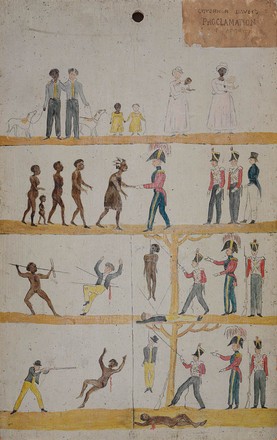
Governor Davey’s Proclamation to the Aborigines, 1816
Oil on board
SAFE / R 247
Purchased from J.W. Beattie, May 1919

Oil on board
SAFE / R 247
Purchased from J.W. Beattie, May 1919
George Arthur (1784-1854), issued several printed Proclamations during his time as Governor of Van Diemen's Land (Tasmania) in an effort to reduce the escalation of violence between the Aboriginal peoples and the British settlers.
George Frankland (1800-1838), the Surveyor General, wrote to Governor Arthur in 1829 and suggested the Proclamation Board as a visual tool to support these printed Proclamations. The Board presents a four-strip pictogram that attempts to explain the idea of equality under the law. Those who committed violent crimes, be they Aboriginal or colonist, would be punished in the same way.
The first image shows Aboriginal people and European settlers living together peacefully. The second image show leaders, representing the British and the Aborigines, shaking hands. In the third image an Aboriginal man spears a male white settler and is hanged; the scene is replicated when a white settler shoot an Aboriginal man and is also hanged.
The Proclamation Board was inspired by the way the Aboriginal people communicated by leaving drawings on the bark of trees. Governor Arthur's Proclamation was painted onto Boards and then mounted on trees in remote areas where they would be seen by Aboriginal people.
Acknowledgements: The author acknowledges the Palawa peoples; the traditional custodians of the lands know today as Tamania. The author acknowledges too, the Gadigal people of the Eora nation upon whose lands these words were researched and written.